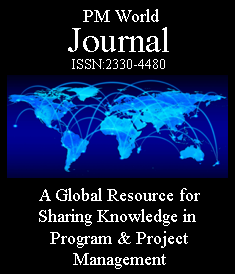Do Your Graphics Aid Others’ Understanding?
Proving Pythagoras: A Case-in-Point
ADVISORY
By Dr. Kenneth Smith, PMP
Honolulu, Hawaii
& Manila, The Philippines
It is often said that ‘a picture is worth a thousand words,’ as it is an extremely effective medium for capturing and conveying information, However, governments often proscribe photography on ‘security’ grounds, while many individuals object for ‘privacy’ reasons. Also, in some areas of the world I encountered situations where taking photographs of people was inappropriate out of respect for local cultural sensitivities, as people feared the camera would capture their spirit. In these circumstances, I was only able to retain fleeting images in my ‘mind’s eye’ for future discussions with others. Nevertheless, other graphics of various kinds can also effectively supplement spoken & written words by condensing numerical data & conceptualizing ideas; as well as depicting and clarifying workflow processes for review, monitoring, analysis & evaluation.
However, due to human limitations, using such aids – as well as being on the receiving end — is not always as effective as anticipated, as genetic dyscalculia[1] and spatial awareness constraints[2] are more prevalent than generally recognized. While not unintelligent — people with dyscalculia have limited ability to compute, convert measurements, utilize mathematical equations, discern the wealth of information embedded in data tables, or spot anomalies readily apparent to others. Spatial awareness limitations make it difficult to visualize & comprehend the intrinsic meaning in charts, histograms, line graphs, Venn diagrams, and chemical symbology. Thus, while additional artifacts can be invaluable aids to explanation & understanding, regrettably, such items may be merely abstract art forms for some recipients![3] But the Project Management community extends beyond professional engineers and accountants, so effective communication with all stakeholders is highly desirable — to the extent feasible.
I too am occasionally bewildered by other’s charts and flow diagrams. So sometimes I need more guidance to envision what they intend for me to see [4] — especially when graphics and tables are only depicted in totality, &/or presenters move on so rapidly before I have fully absorbed their features.
To illustrate my – and Ana Marie’s — point, here’s a recent weather chart depicted on TV news:
More…
To read entire article, click here
How to cite this article: Smith, K. F. (2024). Picture-Perfect; or Perplexing? Do Your Graphics Aid Others’ Understanding? Proving Pythagoras: A Case-in-Point, PM World Journal, Vol. XIII, Issue XI, December. Available online at https://pmworldlibrary.net/wp-content/uploads/2024/12/pmwj147-Dec2024-Smith-Picture-Perfect-or-Perplexing.pdf
About the Author

Dr. Kenneth Smith
Honolulu, Hawaii
& Manila, The Philippines
![]()
Initially a US Civil Service Management Intern, then a management analyst & systems specialist with the US Defense Department, Ken subsequently had a career as a senior foreign service officer — management & evaluation specialist, project manager, and in-house facilitator/trainer — with the US Agency for International Development (USAID). Ken assisted host country governments in many countries to plan, monitor and evaluate projects in various technical sectors; working ‘hands-on’ with their officers as well as other USAID personnel, contractors and NGOs. Intermittently, he was also a team leader &/or team member to conduct project, program & and country-level portfolio analyses and evaluations.
Concurrently, Ken had an active dual career as Air Force ready-reservist in Asia (Japan, Korea, Vietnam, Indonesia, Philippines) as well as the Washington D.C. area; was Chairman of a Congressional Services Academy Advisory Board (SAAB); and had additional duties as an Air Force Academy Liaison Officer. He retired as a ‘bird’ colonel.
After retirement from USAID, Ken was a project management consultant for ADB, the World Bank, UNDP and USAID.
He earned his DPA (Doctor of Public Administration) from the George Mason University (GMU) in Virginia, his MS from Massachusetts Institute of Technology (MIT Systems Analysis Fellow, Center for Advanced Engineering Study), and BA & MA degrees in Government & International Relations from the University of Connecticut (UCONN). A long-time member of the Project Management Institute (PMI) and IPMA-USA, Ken is a Certified Project Management Professional (PMP®) and a member of the PMI®-Honolulu and Philippines Chapters.
Ken’s book — Project Management PRAXIS (available from Amazon) — includes many innovative project management tools & techniques; and describes a “Toolkit” of related templates available directly from him at kenfsmith@aol.com on proof of purchase of PRAXIS.
To view other works by Ken Smith, visit his author showcase in the PM World Library at https://pmworldlibrary.net/authors/dr-kenneth-smith/
[1] Inability to accurately compute arithmetic functions, or fully appreciate quantitative relationships & comparisons.
[2] An inability to relate diagrams with locations — such as reading maps — or physical objects; due to genetic parietal lobe density insufficiency.
[3] Indeed — oblivious to their distinctive color-coding – some participants criticize my colorful templates and power-points. I also vividly recall an individual who after scrutinizing my histograms & line graphs was still unable to comprehend the messages they conveyed; describing them as merely ‘chimney things’ and ‘skyline silhouettes’!
[4] That I am not the only one in this respect is evidenced by the following comment I read recently in a local newspaper: “I must admit that when a PAGASA (Philippine Atmospheric, Geophysical and Astronomical Services Administration) forecaster ran those rainfall outlook numbers through us on One News’ “Storycon” last Wednesday while trying to explain the rain advisories, my math-challenged brain seized like melted chocolate mixed with water. [Emphasis mine.] I’m sure I’m not alone with this problem.” Ana Marie Pamintuan, “Whither Weather?” The Philippine Star, Friday, October 25, 2024.









